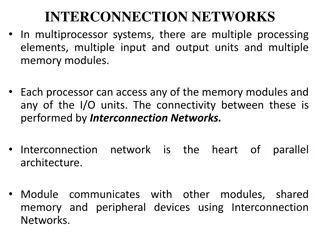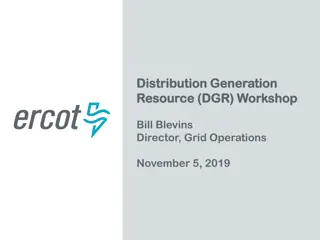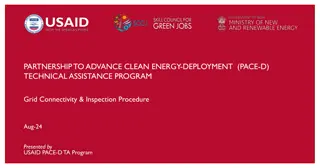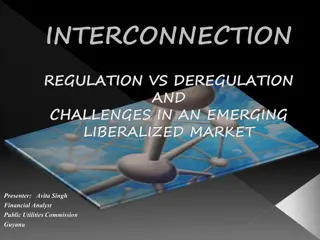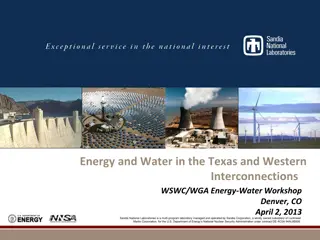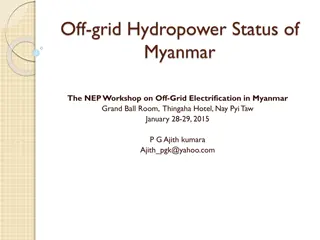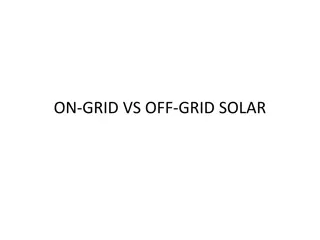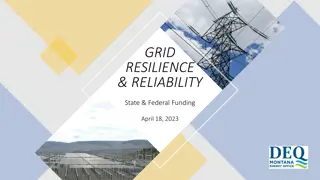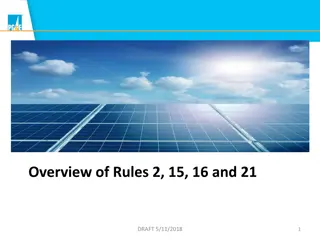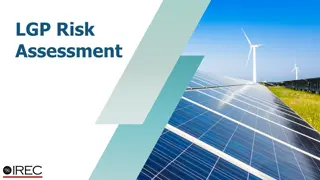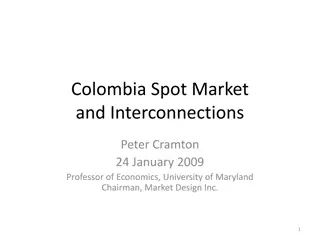Global Energy Interconnection and Power Grid Interconnections
Global Energy Interconnection (GEI) envisions globally interconnected power grids supporting clean, renewable energy transmission worldwide. Ultra-high voltage technology enables efficient long-distance power transmission. The concept originated in the 20th century and was endorsed by the United Nations in 1969. Various regions such as North America have established extensive synchronous power grids interconnected through HVDC lines, benefiting from large-scale power interconnections. GEI aims to provide clean energy to remote areas and reduce reliance on fossil fuels.
Download Presentation

Please find below an Image/Link to download the presentation.
The content on the website is provided AS IS for your information and personal use only. It may not be sold, licensed, or shared on other websites without obtaining consent from the author.If you encounter any issues during the download, it is possible that the publisher has removed the file from their server.
You are allowed to download the files provided on this website for personal or commercial use, subject to the condition that they are used lawfully. All files are the property of their respective owners.
The content on the website is provided AS IS for your information and personal use only. It may not be sold, licensed, or shared on other websites without obtaining consent from the author.
E N D
Presentation Transcript
Dr. Jumana Alshawawreh Associate Professor Electrical Power Engineering Department Tafila Technical University
Global Energy Interconnection definition Benefits of global energy interconnection. Global Large Power Interconnections in : North America, Latin America, Africa, Europe and Northeast Asia. Power system network interconnections and power flow controllers. Case study: Danish power sector. Congestion in interconnected power systems.
The idea of global power grid interconnections was originated in the first half of the 20th century by Buckminster Later, the concept of the global grid was acknowledged by the United Nations (UN) in1969 at the World Game Seminar.
Global energy interconnection (GEI) is a vision of globally interconnected power grids, which can become a platform for large-scale development, transmission and consumption of clean, renewable energy worldwide. Ultra high voltage technology (UHV) can support long-distance power transmission with high efficiency, low losses, and stability, allowing electricity generated from clean energy to be sent to people currently without access to electricity, or using electricity supplied by fossil fuels.
North America: In eastern North America, the total capacity of the synchronous power grids is more than 760 GW installed over 5.2 million km2 of area. These synchronous power grids are the largest installed capacity globally, having 500 kV network and consisting of few 750 kV power networks.
- four synchronous power grids are interconnected asynchronously across the United States, Canada and Mexico, including the eastern and western, together with the Texas and Quebec interconnections - The Eastern interconnection is interconnected to the Western interconnection through six HVDC lines, to the Texas interconnection through two HVDC lines, to the Quebec interconnection through four HVDC lines, and one variable frequency transformer (VFT).
has interconnection, which include the (MERCOSUR, excluding Venezuela), the Andean Community (CAN),and Central America (SIEPAC). The interconnection between Colombia and Panama is expected to start soon having 450 kV and power transmission capacity of 600 MW Moreover, Colombia and transmission lines with a maximum export capacity of 535 MW . Many more cross-border expected in these regions, for example, Colombia plans a new MTDC interconnection project (Guajira- Cerromatoso-Panama) in order to export energy. created three main regions for Southern Cone the grid Ecuador share four interconnections are
The Africa Clean Energy Corridor (ACEC) initiative, taken up by the International Renewable Energy Agency (IRENA) and recognized by Ministers from the Eastern Africa Power Pool (EAPP) countries and the Southern African Power Pool (SAPP) at the fourth IRENA Assembly in 2014. The initiative enhanced deployment in cross-border interconnection and trade of renewable power in a continuous network from Egypt to South Africa. In Eastern and Southern Africa, 80% of electricity is generated from fossil fuels (natural gas, oil, or coal). It is expected that by 2030, 50% of electricity in Eastern and Southern Africa could come from clean and cost-effective renewable . It is proposed that a submarine cable in Africa include the East Africa West Africa Channel and Africa European Interconnected Channel. The total length is 4000 km, while the total capacity is 50 GW.
In Western synchronous power grids attains 690 GW expanded over nearly 4.5 million km2 of area. To fulfill the mission of clean energy development, European countries try to establish a Europe Mediterranean-Middle East super-power grid by 2050. This will interconnect renewable energy power generation bases in the Middle East, North Africa, and areas along the North Sea coast in Europe . The International Energy Agency estimated that the potential from concentrated solar power technology alone in the Middle East and North Africa could amount to 100 times the electricity demand of North Africa,the Middle East and Europe combined. Europe, the installed capacity of
The countries of Northeast Asia (NEA) were previously poorly connected, have started to explore the possibility of constructing interstate electric ties (ISET) and interstate grids (ISG). Northeast Asia power grid consists of synchronized power grids in each country
In 2020, 50% of the electricity consumed by the Danish power sector came from variable renewable energy (VRE) sources, making it the country with the highest VRE share in its power system. During some days, VRE production even exceeded demand, and as a result the power system ran on 100% VRE while the rest was exported.
In 2017, wind contributed close to 44% of the total Danish electricity consumption while solar photovoltaic panels (PV) contributed with about 2%. Furthermore, wind generation exceeds demand in 5% of hours over the year. About 5 GW of wind power capacity and 900 MW of solar power capacity are presently installed in Denmark, with a demand peak load at about 6.5 GW and a total yearly electricity consumption of approximately 33.5 TWh.
Wind power capacity is divided in close to 4 GW onshore and 1 GW offshore installations. The fossil based thermal generation capacity is declining and amounts today to about 4 GW of large central power stations and 2.3 GW of small scale (local) units. In practice, all thermal plants are combined heat and power plants (CHP). The heat is delivered to district heating systems, which distribute the heat to consumers.
1. Denmark is one of the countries in Europe with the strongest power system interconnections. The total capacity of interconnectors to Norway, Sweden and Germany amounts to about 6,000 MW.
2. by a well designed market structure that provide the necessary economic incentives. The power market allows for prices to correctly signal the need for flexibility and therefore rewards power plants that can take advantage of increased flexibility
Flexible thermal power plants: The role of CHP plants changed from base load to key source of flexibility . Besides the production and transmission side, the operation of the Danish power system also underwent a transition so that by 2017 central thermal power plants were no longer required to run
Market experiencing negative electricity prices in situations on periods of excess supply of power production from wind turbines and CHP units. In normal operation, any excess supply was exported to Norway, Sweden and/or Germany, but in some cases, limitations of usage of interconnector capacity or same time excess supply of wind power production in Germany led to situations with prices below zero. 2016-2020 (VRE shares 44-50%) and beyond 50%: focus has shifted towards increased sector coupling and demand-side flexibility. Demand-side flexibility started to be promoted through for example aggregators to actively participate in the balancing of the system as part of a transition from passive to active consumers.
The negative prices on the market created incentives to terminate or at least reduce production when there was no value of electricity. This led to investments in flexibility measures on the demand side, especially driving the market for electric boilers in district heating systems
Congestion is one of the main problems that can limit the RES trading over interconnected systems. Global interconnected system ideally constructed in a way that all possible structural congestions are avoided. It was discovered that around 72 % In EU interconnected systems of all congestion cases were caused by internal network bottlenecks,
In 2002, the European Council set its first electricity capacity interconnection target at 10% for 2020. In May 2014, the European Commission suggested that the interconnection target should be extended to 15% by 2030. To allow competition between different electricity production capacities European transmission system should be ideally constructed in a way that all possible structural congestions are avoided. meaning that wholesale price differences would be minimized or reduced to zero.
creating a large financial income for TSOs due to congestion rents (annual sum of congestion rents in Europe was around 2000 M .
This change in the Spanish net balance trend can be related to two main factors: The growth of Spanish demand due to the improvement in economic activity The withdrawal of certain small, nuclear, coal-fired power plants.
1. Alamri, Basem, Md Alamgir Hossain, and MS Jamil Asghar. "Electric power network interconnection: A review on current status, future prospects and research direction." Electronics 10.17 (2021): 2179. 2. Amrr, Syed Muhammad, et al. "A comprehensive review of power flow controllers in interconnected power system networks." IEEE Access 8 (2020): 18036-18063.
3. Model Analysis of Flexibility of the Danish Power System, May 2018. 4. Development and Role of Flexibility in the Danish Power System Solutions for integrating 50% wind and solar, and potential, future solutions for the remaining 50% , 23 June 2021.
5. Roldan-Fernandez, Juan Manuel, et al. "Cross-border energy exchange and renewable premiums: The case of the Iberian system." Energies 11.12 (2018): 3277. 6. Electricity Interconnection Targets in the Energy Community Contracting Parties Energy Community Secretariat, February 2021.

 undefined
undefined









